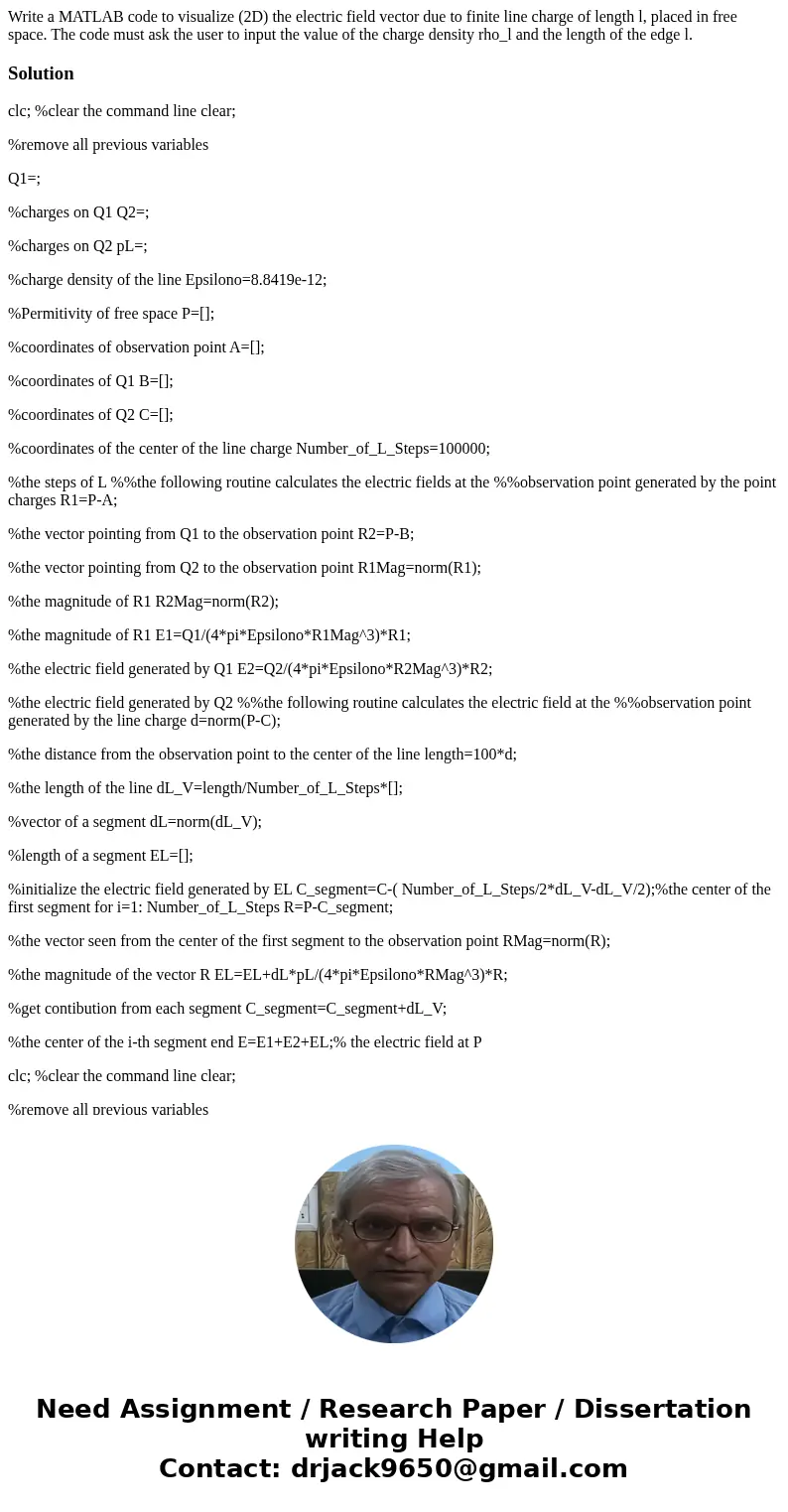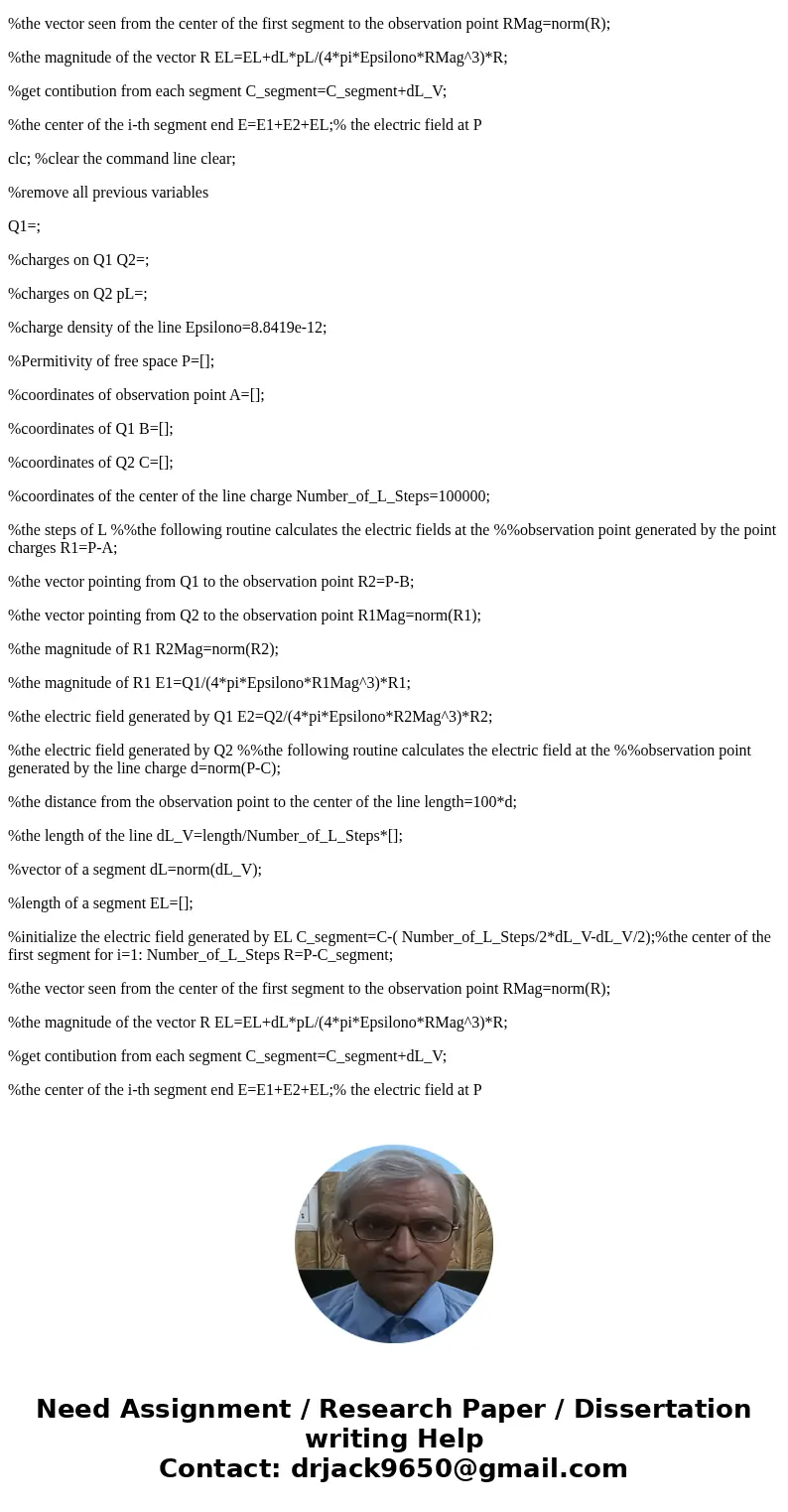Write a MATLAB code to visualize 2D the electric field vecto
Solution
clc; %clear the command line clear;
%remove all previous variables
Q1=;
%charges on Q1 Q2=;
%charges on Q2 pL=;
%charge density of the line Epsilono=8.8419e-12;
%Permitivity of free space P=[];
%coordinates of observation point A=[];
%coordinates of Q1 B=[];
%coordinates of Q2 C=[];
%coordinates of the center of the line charge Number_of_L_Steps=100000;
%the steps of L %%the following routine calculates the electric fields at the %%observation point generated by the point charges R1=P-A;
%the vector pointing from Q1 to the observation point R2=P-B;
%the vector pointing from Q2 to the observation point R1Mag=norm(R1);
%the magnitude of R1 R2Mag=norm(R2);
%the magnitude of R1 E1=Q1/(4*pi*Epsilono*R1Mag^3)*R1;
%the electric field generated by Q1 E2=Q2/(4*pi*Epsilono*R2Mag^3)*R2;
%the electric field generated by Q2 %%the following routine calculates the electric field at the %%observation point generated by the line charge d=norm(P-C);
%the distance from the observation point to the center of the line length=100*d;
%the length of the line dL_V=length/Number_of_L_Steps*[];
%vector of a segment dL=norm(dL_V);
%length of a segment EL=[];
%initialize the electric field generated by EL C_segment=C-( Number_of_L_Steps/2*dL_V-dL_V/2);%the center of the first segment for i=1: Number_of_L_Steps R=P-C_segment;
%the vector seen from the center of the first segment to the observation point RMag=norm(R);
%the magnitude of the vector R EL=EL+dL*pL/(4*pi*Epsilono*RMag^3)*R;
%get contibution from each segment C_segment=C_segment+dL_V;
%the center of the i-th segment end E=E1+E2+EL;% the electric field at P
clc; %clear the command line clear;
%remove all previous variables
Q1=;
%charges on Q1 Q2=;
%charges on Q2 pL=;
%charge density of the line Epsilono=8.8419e-12;
%Permitivity of free space P=[];
%coordinates of observation point A=[];
%coordinates of Q1 B=[];
%coordinates of Q2 C=[];
%coordinates of the center of the line charge Number_of_L_Steps=100000;
%the steps of L %%the following routine calculates the electric fields at the %%observation point generated by the point charges R1=P-A;
%the vector pointing from Q1 to the observation point R2=P-B;
%the vector pointing from Q2 to the observation point R1Mag=norm(R1);
%the magnitude of R1 R2Mag=norm(R2);
%the magnitude of R1 E1=Q1/(4*pi*Epsilono*R1Mag^3)*R1;
%the electric field generated by Q1 E2=Q2/(4*pi*Epsilono*R2Mag^3)*R2;
%the electric field generated by Q2 %%the following routine calculates the electric field at the %%observation point generated by the line charge d=norm(P-C);
%the distance from the observation point to the center of the line length=100*d;
%the length of the line dL_V=length/Number_of_L_Steps*[];
%vector of a segment dL=norm(dL_V);
%length of a segment EL=[];
%initialize the electric field generated by EL C_segment=C-( Number_of_L_Steps/2*dL_V-dL_V/2);%the center of the first segment for i=1: Number_of_L_Steps R=P-C_segment;
%the vector seen from the center of the first segment to the observation point RMag=norm(R);
%the magnitude of the vector R EL=EL+dL*pL/(4*pi*Epsilono*RMag^3)*R;
%get contibution from each segment C_segment=C_segment+dL_V;
%the center of the i-th segment end E=E1+E2+EL;% the electric field at P


 Homework Sourse
Homework Sourse